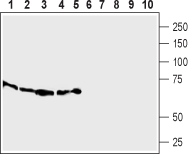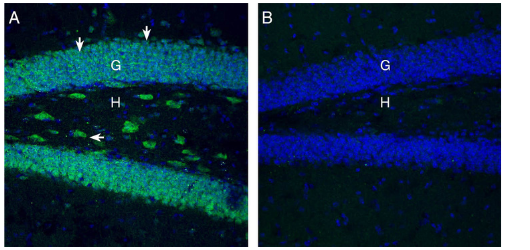Overview
- Peptide (C)KTYFKMNYTGLAE, corresponding to amino acid residues 151-163 of rat SLC7A2 (Accession B5D5N9). 2nd extracellular loop.

 Western blot analysis of Human THP-1 acute monocytic leukemia cells (lanes 1 and 6), mouse WEHI-231 B-cell lymphoma cells (lanes 2 and 7), rat RBL basophilic leukemia cells lysates (lanes 3 and 8), rat heart (lanes 4 and 9) and rat lung membranes (lanes 5 and 10):1-5. Anti-SLC7A2 (extracellular) Antibody (#ANT-103), (1:400).
Western blot analysis of Human THP-1 acute monocytic leukemia cells (lanes 1 and 6), mouse WEHI-231 B-cell lymphoma cells (lanes 2 and 7), rat RBL basophilic leukemia cells lysates (lanes 3 and 8), rat heart (lanes 4 and 9) and rat lung membranes (lanes 5 and 10):1-5. Anti-SLC7A2 (extracellular) Antibody (#ANT-103), (1:400).
6-10. Anti-SLC7A2 (extracellular) Antibody, preincubated with SLC7A2 (extracellular) Blocking Peptide (#BLP-NT103).
 Expression of SLC7A2 (CAT-2) in mouse hippocampusImmunohistochemical staining of perfusion-fixed frozen mouse brain sections with Anti-SLC7A2 (extracellular) Antibody (#ANT-103), (1:300), followed by goat anti-rabbit-AlexaFluor-488. A. Staining in the hippocampal dentate gyrus region, showed SLC7A2 immunoreactivity (green) in neuronal profiles in the granule layer (G, vertical arrows) and in the hilus (H, horizontal arrows). B. Pre-incubation of the antibody with SLC7A2 (extracellular) Blocking Peptide (BLP-NT103), suppressed staining. Cell nuclei are stained with DAPI (blue).
Expression of SLC7A2 (CAT-2) in mouse hippocampusImmunohistochemical staining of perfusion-fixed frozen mouse brain sections with Anti-SLC7A2 (extracellular) Antibody (#ANT-103), (1:300), followed by goat anti-rabbit-AlexaFluor-488. A. Staining in the hippocampal dentate gyrus region, showed SLC7A2 immunoreactivity (green) in neuronal profiles in the granule layer (G, vertical arrows) and in the hilus (H, horizontal arrows). B. Pre-incubation of the antibody with SLC7A2 (extracellular) Blocking Peptide (BLP-NT103), suppressed staining. Cell nuclei are stained with DAPI (blue).
- Sans-Fons, M.G. et al. (2013) J. Infect Dis. 207, 93.
- Wanasen, N. and Soong, L. (2008) Immunol. Res. 41, 15.
- King, N.E. et al. (2004) J. Nutr. 134, 2830.
- Scumpia, P.O. et al. (2002) Am. J. Physiol. 283, 1231.
- Niese, K.A. et al. (2010) Respir. Res. 11, 87.
The cationic amino acid transporter (CAT) family is comprised of four homologous membrane proteins: CAT-1, CAT-2, CAT-3 and CAT-4, encoded by the SLC7A1−4 genes, respectively. The major difference between these transporters is at the level of tissue specificity and regulation of their expression1,2.
The CAT family is included in the Na+-independent transport system, (named system y+) that mediate L-arginine uptake in most tissues and cells3.
CAT-2 (SLC7A2) is known to transport cationic amino acids such as L-arginine, L-ornithine, and L-lysine. It is considered to be the major arginine transporter in most cells and tissues. It can be expressed in two spliced variants, CAT-2A and CAT-2B. CAT-2A, is a low-affinity transporter, constitutively expressed in liver and muscle cells, whereas CAT-2B, is a high-affinity transporter, abundantly expressed in macrophages3.
Macrophages isolated from mice deficient in CAT-2 show impaired ability to transport arginine intracellularly and to produce nitric oxide in response to endotoxin, thus CAT2 may also be important in regulating immune cell function in inflammation4.
Studies have identified CAT2 as a regulator of fibrotic responses in the lung5.
Application key:
Species reactivity key:
Anti-SLC7A2 (extracellular) Antibody (#ANT-103) is a highly specific antibody directed against an epitope of the rat protein. The antibody can be used in western blot analysis. It recognizes an extracellular epitope and can potentially detect the protein in living cells. It has been designed to recognize Cationic amino acid transporter 2 from mouse, rat, and human samples.

